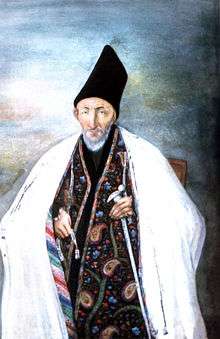Haji Mirza Aqasi
Haji Mirza Akasi or Aghasi (Persian: حاج میرزا آقاسی), sometimes known as Haji-Mollah Abbas Iravani, was the Sadr-e Azam (equivalent to prime minister) of Qajar Iran between 1835-1848, during the reign of king Mohammad Shah Qajar.
Hāji Mirzã Ākãsi | |
|---|---|
 Aqasi as painted by Sani ol molk, 1846. | |
| Prime Minister of Qajar Iran | |
| Monarch | Mohammad Shah Qajar |
| Personal details | |
| Born | Haji Mirza Abbas Iravani c. 1783 Maku, Qajar Iran |
| Died | c. 1848 Ottoman Iraq |
| Nationality | Qajar Iranian |
| Occupation | Prime-Minister |
Biography

Aqasi was born and brought up in Maku to a certain Moslem ibn Abbas, a "petty" Mollah landowner of the city of Īravān (Yerevan), then still part of Iran, and a member of the Bayat clan.[2][3]
Mirza Akasi initiated Mohammad Shah into Sufi mysticism, and the two men "came to be known as two 'dervishes'."[4] While he has often been criticized for contributing to the disasters of the reign, it is possible that he was attempting to use Sufism as a weapon against the growing hold of the official representatives of religion, the mullahs, who were opposing both modernization and foreign influence.
In foreign affairs, he managed to "prevent Iran disintegrating either into autonomous principalities or appanages of Russia, and Britain," and internally he "revived the cultivation of the mulberry tree in the Kerman region, to feed silkworms; and he envisaged the diversion of the waters of the River Karaj for Tehran's water-supply."[5]
The failure of Haji Mirza Akasi's countrymen to praise him for his enterprise was partly no doubt due to an equally shrewd appreciation on their part that new economic alignments emerging during his period as Prime Minister were not destined to enrich the people, but only to make a rapacious aristocracy more powerful, while the situation of the cultivator became little better than slavery.[6] Shoghi Effendi, head of the Bahá'í Faith in the first half of the 20th century, described Haji Mirza Aqasi as "the Antichrist of the Bábí Revelation."[7]
References
- "Portrait of Muhammad Shah Qajar and his Vizier Haj Mirza Aghasi".
- Amanat 1986, pp. 183–188.
- Moomen 1981, p. 154.
- Avery, Modern Iran, p. 30.
- Avery, Modern Iran, pp. 46-7.
- Avery, Modern Iran, p. 47.
- Shoghi Effendi, God Passes By, 164.
Sources
- Peter Avery, Modern Iran, Praeger, 1965.
- Effendi, Shoghi (1944). God Passes By. Wilmette, IL: Bahá'í Publishing Trust.
- Amanat, A. (1986). "ĀQĀSĪ". Encyclopaedia Iranica, Vol. II, Fasc. 2. pp. 183–188.CS1 maint: ref=harv (link)
- Momen, Moojan (1981). The Bábí and Bahá'í Religions 1844-1944: Some Contemporary Western Accounts. G. Ronald. ISBN 978-0853981022.CS1 maint: ref=harv (link)
- Amanat Abbas : « Iran, a modern history », Yale University Press, 2017